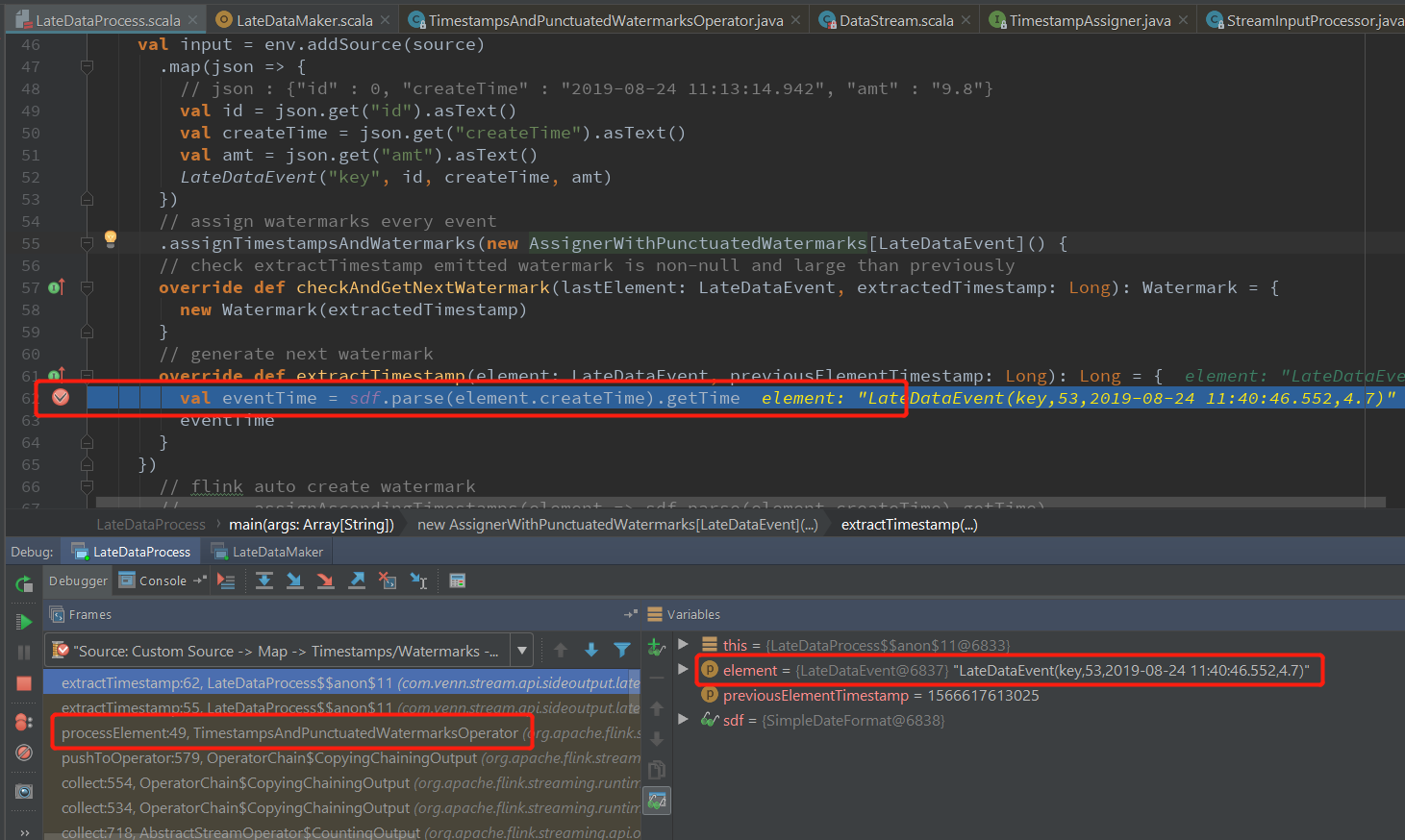相信会看到这篇文章的都对Flink的时间类型(事件时间、处理时间、摄入时间)和Watermark有些了解,当然不了解可以先看下官网的介绍:https://ci.apache.org/projects/flink/flink-docs-master/dev/event_time.html
这里就会有这样一个问题:FLink 是怎么基于事件时间和Watermark处理迟到数据的呢?
在回答这个问题之前,建议大家可以看下下面的Google 的三篇论文,关于流处理的模型:
https://www.vldb.org/pvldb/vol8/p1792-Akidau.pdf 《The Dataflow Model: A Practical Approach to Balancing Correctness, Latency, and Cost in Massive-Scale, Unbounded, Out-of-Order Data Processing》
high-level的现代数据处理概念指引:
https://www.oreilly.com/ideas/the-world-beyond-batch-streaming-101
https://www.oreilly.com/ideas/the-world-beyond-batch-streaming-102
---------------------------进入正题--------------------------------
现在进入正题:FLink 是怎么基于事件时间和Watermark处理迟到数据的呢?
这个问题可以分成两个部分:
1. 基于事件时间创建Timestamp 和Watermark(后面会详细介绍)
2. 处理迟到数据
1. 基于事件时间创建Timestamp 和Watermark
为了方便查看,这里使用 assignTimestampsAndWatermarks(assigner: AssignerWithPeriodicWatermarks[T]): DataStream[T] 重载方法基于每个事件生成水印代码如下:
val input = env.addSource(source) .map(json => { // json : {"id" : 0, "createTime" : "2019-08-24 11:13:14.942", "amt" : "9.8"} val id = json.get("id").asText() val createTime = json.get("createTime").asText() val amt = json.get("amt").asText() LateDataEvent("key", id, createTime, amt) }) // assign watermarks every event .assignTimestampsAndWatermarks(new AssignerWithPunctuatedWatermarks[LateDataEvent]() { // check extractTimestamp emitted watermark is non-null and large than previously override def checkAndGetNextWatermark(lastElement: LateDataEvent, extractedTimestamp: Long): Watermark = { new Watermark(extractedTimestamp) } // generate next watermark override def extractTimestamp(element: LateDataEvent, previousElementTimestamp: Long): Long = { val eventTime = sdf.parse(element.createTime).getTime eventTime } })
```
扩展:数据在算子中是以StreamRecord 对象作为流转抽象结构如下:
public final class StreamRecord<T> extends StreamElement { /** The actual value held by this record. 具体数据*/ private T value; /** The timestamp of the record. 该数据对应的时间戳 */ private long timestamp; }
StreamElement 也是 Watermark 和 StreamStatus的父类,简单来说就是Flink 承载消息的基类(这里可以指定,Watermark 是和事件一个级别的抽象,而Timestamp 是Watermark和事件的成员变量,代表Watermark和事件的时间)
```
assignTimestampsAndWatermarks 是基于事件的数据(extractTimestamp 方法中返回的Timestamp),替换StreamRecord 对象中的Timestamp和发出新的Watermark(如果当前事件的Timestamp 生成的Watermark大于上一次的Watermark)
下面我们来debug这部分源码:
首先在extractTimestamp 方法中添加断点查看Timestamp 和Watermark的生成:

TimestampsAndPunctuatedWatermarksOperator.processElement(使用的类取决于assignTimestampsAndWatermarks 方法的参数) 中处理事件的Timestamp和对应的Watermark
StreamRecord对象的创建在 StreamSourceContexts.processAndCollectWithTimestamp 中,使用的Timestamp 是数据在kafka的时间,在KafkaFetcher.emitRecord方法中从consumerRecord中获取:
KafkaFetcher.emitRecord 发出从kafka中消费到的数据:
protected void emitRecord( T record, KafkaTopicPartitionState<TopicPartition> partition, long offset, ConsumerRecord<?, ?> consumerRecord) throws Exception { emitRecordWithTimestamp(record, partition, offset, consumerRecord.timestamp()); }

StreamSourceContexts.processAndCollectWithTimestamp 创建StreamRecord 对象
protected void processAndCollectWithTimestamp(T element, long timestamp) { output.collect(reuse.replace(element, timestamp)); // 放入真正的事件时间戳 }

下面我们来看 TimestampsAndPunctuatedWatermarksOperator.processElement 的源码
@Override public void processElement(StreamRecord<T> element) throws Exception { // 获取这条数据 final T value = element.getValue(); // userFunction 就是代码里面创建的匿名类 AssignerWithPunctuatedWatermarks // 调用extractTimestamp,获取新的Timestamp // element.hasTimestamp 有的话就用,没有就给默认值long类型 的最小值 final long newTimestamp = userFunction.extractTimestamp(value, element.hasTimestamp() ? element.getTimestamp() : Long.MIN_VALUE); // 使用新的Timestamp 替换StreamRecord 旧的Timestamp output.collect(element.replace(element.getValue(), newTimestamp)); // 获取下一个Watermark,调用实现的 checkAndGetNextWatermark 方法 final Watermark nextWatermark = userFunction.checkAndGetNextWatermark(value, newTimestamp); // 如果新的Watermark 大于上一个Watermark 就发出新的 if (nextWatermark != null && nextWatermark.getTimestamp() > currentWatermark) { currentWatermark = nextWatermark.getTimestamp(); output.emitWatermark(nextWatermark); } }
至此Timestamp和Watermark的创建(或者说生成)就好了
2. Flink 处理迟到数据
为了演示这个功能,在上面的程序中添加了window算子和迟到数据侧边输出的方法 sideOutputLateData,为了方便查看,这里再添加一次全部代码
val source = new FlinkKafkaConsumer[ObjectNode]("late_data", new JsonNodeDeserializationSchema(), Common.getProp) // 侧边输出的tag val late = new OutputTag[LateDataEvent]("late") val input = env.addSource(source) .map(json => { // json : {"id" : 0, "createTime" : "2019-08-24 11:13:14.942", "amt" : "9.8"} val id = json.get("id").asText() val createTime = json.get("createTime").asText() val amt = json.get("amt").asText() LateDataEvent("key", id, createTime, amt) }) // assign watermarks every event .assignTimestampsAndWatermarks(new AssignerWithPunctuatedWatermarks[LateDataEvent]() { // check extractTimestamp emitted watermark is non-null and large than previously override def checkAndGetNextWatermark(lastElement: LateDataEvent, extractedTimestamp: Long): Watermark = { new Watermark(extractedTimestamp) } // generate next watermark override def extractTimestamp(element: LateDataEvent, previousElementTimestamp: Long): Long = { val eventTime = sdf.parse(element.createTime).getTime eventTime } }) // after keyBy will have window number of different key .keyBy("key") .window(TumblingEventTimeWindows.of(Time.minutes(1))) // get lateData .sideOutputLateData(late) .process(new ProcessWindowFunction[LateDataEvent, LateDataEvent, Tuple, TimeWindow] { // just for debug window process late data override def process(key: Tuple, context: Context, elements: Iterable[LateDataEvent], out: Collector[LateDataEvent]): Unit = { // print window start timestamp & end timestamp & current watermark time println("window:" + context.window.getStart + "-" + context.window.getEnd + ", currentWatermark : " + context.currentWatermark) val it = elements.toIterator while (it.hasNext) { val current = it.next() out.collect(current) } } }) // print late data input.getSideOutput(late).print("late:") input.print("apply:") env.execute("LateDataProcess")
代码逻辑很简单,主要是为了加入window算子,process算子是为了方便debug到window算子中
下面开始debug源码:
在process 方法中添加断点:

这次直接从window算子接收上游发过来的数据开始看起:
StreamInputProcessor.processInput方法负责将接收到的事件(数据、Watermark、StreamStatus、LatencyMarker),反序列化为 StreamElement(上文已经说得了,是事件抽象的基类),判断具体是那种消息,分别进行处理
public boolean processInput() throws Exception { while (true) { if (currentRecordDeserializer != null) { DeserializationResult result = currentRecordDeserializer.getNextRecord(deserializationDelegate); if (result.isBufferConsumed()) { currentRecordDeserializer.getCurrentBuffer().recycleBuffer(); currentRecordDeserializer = null; } if (result.isFullRecord()) { StreamElement recordOrMark = deserializationDelegate.getInstance(); if (recordOrMark.isWatermark()) { // handle watermark statusWatermarkValve.inputWatermark(recordOrMark.asWatermark(), currentChannel); continue; } else if (recordOrMark.isStreamStatus()) { // handle stream status statusWatermarkValve.inputStreamStatus(recordOrMark.asStreamStatus(), currentChannel); continue; } else if (recordOrMark.isLatencyMarker()) { // handle latency marker synchronized (lock) { streamOperator.processLatencyMarker(recordOrMark.asLatencyMarker()); } continue; } else { // now we can do the actual processing StreamRecord<IN> record = recordOrMark.asRecord(); synchronized (lock) { numRecordsIn.inc(); streamOperator.setKeyContextElement1(record); streamOperator.processElement(record); } return true; } } } }
注:代码比较长,挑选了跟这次主题相关的部分
Watermark:

数据:

这里我们主要看数据的处理逻辑:
// now we can do the actual processing StreamRecord<IN> record = recordOrMark.asRecord(); synchronized (lock) { // metric 的Counter,统计有多少条数据进来 numRecordsIn.inc(); // 选择当前的key(类似与数据分区,每个key一个,里面存储自己的states) streamOperator.setKeyContextElement1(record); // 真正在进到WindowOperator 中处理数据了 streamOperator.processElement(record); }
就到了 WindowOperator.processElement 方法(主要判断逻辑都在这里)
// 判断windowAssigner 是不是MergingWindowAssigner if (windowAssigner instanceof MergingWindowAssigner)
区分开会话窗口和滑动、跳动窗口的处理逻辑,会话窗口的各个key的窗口是不对齐的

直接到 else部分:
} else { for (W window: elementWindows) { // drop if the window is already late 判断窗口数据是否迟到 // 是,就直接跳过这条数据,重新处理下一条数据 if (isWindowLate(window)) { continue; }
PS: 写了这么久,终于到迟到数据处理的地方了 -_-
下面看下 isWindowLate 部分的处理逻辑:
/** * Returns {@code true} if the watermark is after the end timestamp plus the allowed lateness * of the given window. */ protected boolean isWindowLate(W window) { // 只有事件时间下,并且 窗口元素的最大时间 + 允许迟到时间 <= 当前Watermark 的时候为true(即当前窗口元素迟到了) return (windowAssigner.isEventTime() && (cleanupTime(window) <= internalTimerService.currentWatermark())); } /** * Returns the cleanup time for a window, which is * {@code window.maxTimestamp + allowedLateness}. In * case this leads to a value greater than {@link Long#MAX_VALUE} * then a cleanup time of {@link Long#MAX_VALUE} is * returned. * 返回窗口的cleanup 时间, 窗口的最大时间 + 允许延迟的时间 * @param window the window whose cleanup time we are computing. */ private long cleanupTime(W window) { if (windowAssigner.isEventTime()) { long cleanupTime = window.maxTimestamp() + allowedLateness; return cleanupTime >= window.maxTimestamp() ? cleanupTime : Long.MAX_VALUE; } else { return window.maxTimestamp(); } }
看一条正常到达的数据:
{"id" : 891, "createTime" : "2019-08-24 17:51:44.152", "amt" : "5.6"}


891 这条数据的事件时间是:2019-08-24 17:51:44.152 ,1 分钟的整分窗口,这条数据对应的窗口就是: [2019-08-24 17:51:00.000, 2019-08-24 17:52:000) ,对应的时间戳是 : [1566640260000, 1566640320000) ,当前的Watermark 是 : 1566640294102,窗口数据的最大时间戳大于 当前的Watermark, 不是迟到数据,不跳过。
现在在来看一条迟到的数据:
{"id" : 892, "createTime" : "2019-08-24 17:51:54.152", "amt" : "3.6"}
892 这条数据的事件时间是:2019-08-24 17:51:54.152 ,1 分钟的整分窗口,这条数据对应的窗口就是: [2019-08-24 17:51:00.000, 2019-08-24 17:52:000) ,对应的时间戳是 : [1566640260000, 1566640320000) ,当前的Watermark 是 : 1566652224102 ,窗口数据的最大时间戳小于 当前的Watermark, 数据是迟到数据,跳过。
上面就是窗口对迟到数据的处理源码dubug了,到这里就已经讲完Flink 处理迟到数据的两个部分:
1. 基于事件时间创建Timestamp 和Watermark(后面会详细介绍) 2. 窗口处理迟到数据
注: 这里加上“窗口”,明确是window 算子做的这些事情
下面在来看下窗口迟到输出的SideOutput ,源码在:WindowOperator.processElement 方法的最后一段:
// side output input event if 事件时间 // element not handled by any window 没有window处理过这条数据,上面isSkippedElement 默认值为true,如果上面判断为迟到数据,isSkippedElement就会为false // late arriving tag has been set // windowAssigner is event time and current timestamp + allowed lateness no less than element timestamp if (isSkippedElement && isElementLate(element)) { // 设置了 lateDataOutputTag 即window 算子后面的 .sideOutputLateData(late) if (lateDataOutputTag != null){ sideOutput(element); } else { this.numLateRecordsDropped.inc(); } } /** * Decide if a record is currently late, based on current watermark and allowed lateness. * 事件时间,并且 元素的时间戳 + 允许延迟的时间 <= 当前watermark 是为true * @param element The element to check * @return The element for which should be considered when sideoutputs */ protected boolean isElementLate(StreamRecord<IN> element){ return (windowAssigner.isEventTime()) && (element.getTimestamp() + allowedLateness <= internalTimerService.currentWatermark()); } /** * Write skipped late arriving element to SideOutput. * * @param element skipped late arriving element to side output */ protected void sideOutput(StreamRecord<IN> element){ output.collect(lateDataOutputTag, element); }
搞定
欢迎关注Flink菜鸟公众号,会不定期更新Flink(开发技术)相关的推文
